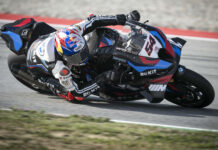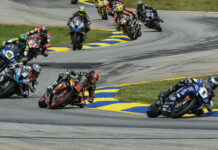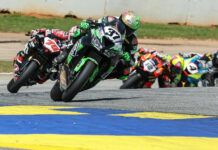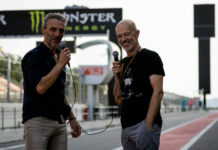From press releases:
PROTON JOINS THE HISTORY MAKERS
A new era in motorcycle racing begins on Sunday – and Proton Team KR will be among those writing their name in the new chapter in the history books.
The occasion is the Japanese Grand Prix, where the new 990cc MotoGP four-strokes will be seen for the first time, for the first battle against the established 500cc two-strokes.
The Proton KR3 is defending the faith. The three-cylinder lightweight machine is a two-stroke – nimble, responsive, and highly polished over three generations of development. The new four-stroke machines are more powerful and have a higher top speed. But they are also heavier, and very new, with all the race-development still to be done.
The KR3’s nimble handling could be a crucial factor at the opening round. The Japanese GP is at the Suzuka circuit – long and fast, but also highly technical, with corner sets running one into the other. A machine that can hold a faithful cornering line can make up a lot through these sections, to compensate for a relative lack of speed on the track’s two straights.
Proton Team KR is the only truly independent team in the highest level of GP racing, and comes to the fray this year with two new riders, as well as a change in tyre supplier.
The riders are both experienced men – Jeremy McWilliams from Northern Ireland, and Japanese star Nobuatsu Aoki.
The tyres are Japanese Bridgestones, making their entry in the top class for the first time, after a full year of high-intensity testing. Aoki was one of two full-time test riders for the team.
The Japanese GP is the first of 16 rounds in the 2002 MotoGP World Championship, with the South African GP in two weeks time, before the start of the European season.
JEREMY McWILLIAMS – SHORTER IS SWEETER
“It seems this is a track where the Bridgestones work well – especially if there is some temperature, so I’m hoping the race will be warm. I’ve already gone faster than last year’s qualifying time, and though it’s a bit off-putting to see the four-strokes setting such fast times, there’s still the question of tyre life, and how many laps they can run at those speeds. I’ve changed the bike a fair bit since my first ride – I’m using a shorter chassis, which turns quicker. It works well through the first section of the track here, through the Esses, which is where we’ll be looking to make up the most time.”
NOBUATSU AOKI – TURNING FOR THE BETTER
“The testing here went pretty well – though I made a couple of mistakes when I was going for a fast lap, and I was a little off my target. I did a lot of testing with the 17-inch rear Bridgestone, which turns better than the 16.5. It worked well, but because of trying different tyres I didn’t have a chance to work on chassis settings to solve some chattering problems. I’ll concentrate on that during qualifying. The KR3 can run with the four-cylinder two-strokes, so I am quite optimistic for the race.”
KENNY ROBERTS – TEAM OWNER
“I hope it rains like hell – I think our tyres could be an advantage if it does, and our bike works well in the wet. The odds will be better in the wet. Either way, we picked a good tyre during testing. The main thing for us is to get out bike better than it was last year – that’s the progress we’re aiming for.”
HONDA RACING NEWS
2002 MotoGP 500 World Championship, round 1
Japanese Grand Prix, Suzuka
April 5/6/7 2002
ROSSI LEADS FOUR-STROKE CHARGE AT SUZUKA
This weekend motorcycle GP racing speeds into its new four-stroke era at Suzuka, where the Japanese Grand Prix opens the 16-race 2002 MotoGP World Championship which throws 990cc four-strokes into battle with 500cc two-strokes. It is perhaps fitting that the figure-of-eight circuit should be chosen to lift the curtain on this exciting new period in racing, for Suzuka first opened four decades ago in 1962, when the dominant four-strokes were locked in combat with a growing threat from the two-strokes.
The ultra-challenging track was constructed at the command of Honda founder Soichiro Honda, so success at this venue is of huge importance to the Honda Motor Company. Last year’s Japanese GP at Suzuka was possibly the factory’s greatest moment in more than 50 years of motorcycling success. Honda riders won all three GPs – 125, 250 and 500 – with Valentino Rossi taking victory in the premier class to score the marque’s 500th Grand Prix success. This was the first of Rossi’s 11 victories during 2001 which gave him the last-ever 500 crown. Now the sublimely talented Italian returns to Suzuka aboard his all-new four-stroke MotoGP bike, the awesome RC211V, aiming to begin the new era as he ended the last, with victory.
Rossi’s winter testing form has been phenomenal. He has shattered lap records wherever he’s tested, from Sepang in Malaysia, to Valencia in Spain and at Suzuka, where he topped a group teams’ test session last weekend. The 23-year old is already firm favourite for the 2002 MotoGP crown but he warns against over-optimism.
“Some people say I’ve already won the championship but I’m not so sure,” says Rossi (Repsol Honda Team RC211V). “The Italian media give me a lot of pressure and (Loris) Capirossi and (Max) Biaggi also say I’ve already won it, they say only I can lose this championship. I’ll give 100 per cent to try to win and I’m sure the others will give 110 per cent to beat me.
“But the RCV is incredible. The first time I tested it at Suzuka last July we found quite a few problems, the second time at Jerez last November it wasn’t so good, but we made a good test. I’m good at understanding what I want from the bike and HRC are very good at giving me what I want. Since the Jerez tests everything has basically changed: the engine character, all the electronic parts, the cowling, the seat, it’s a new bike.”
Last Sunday Rossi recorded the quickest-ever motorcycle lap at Suzuka, at 2:04.343s, leading a Honda one-two-three. Second fastest was team-mate Tohru Ukawa (Repsol Honda Team RC211V), underlying the V5’s stunning performance, with reigning 250 World Champion Daijiro Katoh (Fortuna Honda Gresini NSR500) third on his NSR500 two-stroke.
“We set some good lap times during the tests,” Rossi adds. “And we tested many things to find good set-up solutions for the race. We worked very hard and are finally satisfied with the development of the bike. Now we have three days rest and we’re anxious to see what will happen next Sunday when the two-strokes and four-strokes race together for the first time.”
Although he’ll be doing his best to relax before next weekend, Rossi will spend one day in Honda’s wind-tunnel facility, evaluating the RCV’s aerodynamics, along with Ukawa, who is also deeply impressed with Honda’s first four-stroke bike in two decades.
“The RCV was very fast right from the start, but we had to work to improve drivability out of the corners,” says the former 250 GP winner. “The bike is definitely my favourite machine, it’s better than the two-stroke because it’s got flatter power and torque curves, so it’s easier on the gas. The regulations demand the four-strokes to be 15 kilos heavier than the 500, so you get a little snaking into corners and you carry less corner speed.
“This year is going to be very interesting, I hope to fight with Rossi for the World Championship. Last time I fought with him was in ’99 when we were contesting the 250 World Championship. That year I was with Honda and he
was with Aprilia and he won the title. This year I’ve got the same bike and the same team, so there can be no excuses for me. I’m looking forward to a good battle with him!
“I can’t wait for the Suzuka race. The circuit has changed a little this year. They’ve changed Dunlop curve to make it safer, the corner is now tighter and slower, but I think that lap times are faster because the track is around 30 metres shorter.”
While Rossi and Ukawa focus on developing the all-new RCV, Katoh has quickly got to grips with the latest version of Honda’s NSR500, the most successful bike in 500 GP history. During recent private HRC tests at Suzuka he was a fraction faster than Rossi, at 2:04.40s, and is widely expected to be the quickest 500 rider when he makes his MotoGP debut on Sunday.
“This NSR500 still has great potential,” he says. “I’m learning about the machine and although it’s not an easy job, I feel pretty confident. During last weekend’s tests we tried new solutions for the suspension and chassis and we know which direction to work in for the race.”
Four other riders use NSR500s in this year’s MotoGP series and all are keen to get the season underway. Loris Capirossi (West Honda Pons NSR500), who finished third in last year’s 500 series, has also been very fast in pre-season tests. “Winter tests have shown we still have a good chance with the 500, especially at some tracks,” says the Italian. “My Suzuka lap times improved during last weekend’s tests and I got close to the leaders. Now I’m looking forward to the start of the World Championship, because racing is much more fun than testing!”
Team-mate Alex Barros (West Honda Pons NSR500) has been more circumspect in testing, concentrating on perfecting settings rather than going for ultra-quick lap times. “We’ve been looking at various aspects of machine performance, working in different directions to test different solutions,” says the veteran Brazilian, who made his GP debut way back in 1986. “Suzuka is going to be a very interesting race, I think everyone is looking forward to the weekend; I just hope the weather is okay.”
Jurgen van den Goorbergh (Kanemoto Racing Honda NSR500) and Tetsuya Harada (Pramac Honda NSR500) will also be on the grid at Suzuka next weekend, along with HRC test rider Shinichi Itoh.
Itoh, a former All Japan Superbike Champion and 500 grand prix rider, will race an RCV in HRC colours on Sunday. The Japanese star has been on the pace in testing, setting top ten times at the recent IRTA test at Suzuka.
In the 250 class Honda’s two NSR250-mounted title challengers are Emilio Alzamora (Fortuna Honda Gresini NSR250) and Robby Rolfo (Fortuna Honda Gresini NSR250). Alzamora, who returned to the 250 class last year after winning the 1999 125 title, has high hopes of challenging for the 250 crown. “We are in good shape for the new season and the bike is great,” says Alzamora. “Suzuka will be difficult as always, mainly because there will be many wild card riders there. But we’ll do our best and go on to the next races, determined to score consistent finishes at every race. That is the secret to winning a world title.”
Rolfo, who rode a privateer Aprilia in 2001, has spent the winter acquainting himself with his user-friendly NSR. “The bike is very different to what I’m used to but I really like it,” says the young Italian. “The first races are going to be very interesting. Suzuka is very important though my focus is the full season. I can’t wait to get started.”
Honda-mounted wild card entries in the Suzuka 250 GP are Shinichi Nakatomi, Chojun Kameya, Daisaku Sakai and Hiroshi Aoyama.
Sunday’s Japanese GP will commence with the 125 race, won last year by Masao Azuma (Liégeois Competition Honda RS125) who hopes to begin another strong title challenge on home tarmac. Azuma is joined on Honda machinery by Spanish teenage sensations Daniel Pedrosa and Joan Olive (MoviStar Junior Team) and many others.
After Sunday’s racing the GP circus packs up and heads to South Africa for the Welkom GP on April 21. The long European season begins at Jerez, in
Spain, on May 5. The 2002 campaign ends in Spain, at Valencia, on November 3.
Kanemoto Racing
SUZUKA HOSTS A NEW TEAM AT THE START OF A NEW ERA
Sunday 7 April 2002 will mark an historic date in motorcycle racing, as the Japanese Grand Prix lifts the lid on the start of the most eagerly awaited season in grand prix history. The Suzuka race also marks the welcome return of Kanemoto Racing, under the direction of Erv Kanemoto with the proven Dutch rider Jurgen van den Goorbergh at the helm of the factory Honda NSR500.
The unique figure of eight, 5.821kms circuit will inaugurate the start of the most unpredictable season in 50 years. For the first time ever, 990cc four-stroke machines will be allowed to compete against the all-conquering 500cc two-strokes in the 16 round championship battle.
Van den Goorbergh is set for the fray aboard his first factory machine ride and determined to make the most of the opportunity. The 32-year-old former 250cc and 500cc Privateer Champion has been rewarded for all his hard work and determination during an 11-year grand prix career and he is delighted with the opportunity to join Erv Kanemoto’s new team.
“This is a great opportunity for me and it will be so good to start the season on the Honda NSR at Suzuka, heart of the Honda organisation, on a machine which is performing so well. The NSR is giving me more power than I’ve ever had before I must now make sure I can use that power to our absolute advantage.”
Kanemoto’s Technical and Management pedigree is unrivalled, having clinched seven world championship titles and a staggering 64 grand prix victories, in a 21-year career in the most demanding of world sporting arenas. Kanemoto built up his reputation as a top tuner in the United States before coming to Europe to work for former world champion Barry Sheene in 1981. Since then he has masterminded world championship titles for; Freddie Spencer, Eddie Lawson, Luca Cadalora and Max Biaggi and also worked with world champions Wayne Gardner and John Kocinski.
The Team returns after a two-year racing absence during which time they were involved in tyre development and testing for Bridgestone, a partnership that continues into the 2002 season.
“It’s great to be starting with such a competitive package we have the opportunity to combine the well-proven Honda NSR with the experience of Jurgen, who has really shown his potential over recent years. We are also very excited to be riding on Bridgestone tyres, after working on testing programmes with them last year and seeing first-hand their commitment to the development of racing.” Explained Team Owner and Manager Erv Kanemoto.
The combination of Kanemoto and Van den Goorbergh is set to give the new four-strokes a tough time in what promises to be a superb opening season to the all-new, renamed MotoGP World Championship.
SUZUKA FACT FILE
Suzuka has hosted the Japanese Grand Prix every year from 1987, apart from 1999. Circuit reduced in length this year by 38.13m with the alterations to the Dunlop curve. The slope on the sweeping uphill left-hander has been moderated improving visibility into the corner. The corner has also been shifted further to the left, allowing run off area on outside to be increased.
Length: 5.821kms
Width: 15m
Direction: Clockwise
Pole position: left
Right corners: 11
Left corners: 9
Longest straight: 1.200m
Constructed: 1961
Modified: 2002
Lap Record (old circuit): Tohru Ukawa Jpn (Honda), 2:06.805 – 166.337kmh
8/4/01.
2001 Pole-setting lap (old circuit): Loris Capirossi ITA (West Honda Pons) 2:04.777.
2001 500cc Race Winner (old circuit): Valentino Rossi ITA (Honda) 44:51.501, 164.570kmh.
Race Teams Preview This Weekend’s MotoGP Opener In Japan, And Kenny The Elder Hopes For Rain
Race Teams Preview This Weekend’s MotoGP Opener In Japan, And Kenny The Elder Hopes For Rain
© 2002, Roadracing World Publishing, Inc.






